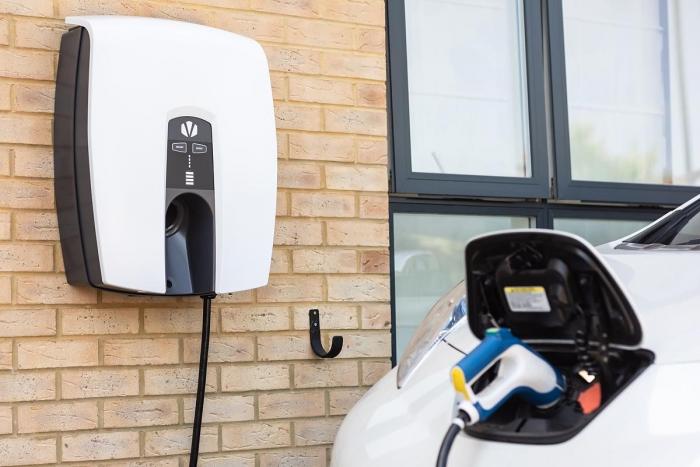
The IMET initiative spoke with Alfred Ireland, EV Commercial Manager at OVO Energy about their Vehicle-to-Grid (V2G) trial and their mission to power human progress with clean, affordable energy for everyone.

What is the OVO Energy V2G trial?
The OVO V2G trial is part of the UK’s Vehicle-to-Grid competition, funded by the Office for Low Emission Vehicles (OLEV) and the Department for Business Energy and Industrial Strategy (BEIS), in partnership with Innovate UK. Under the project, OVO Energy has installed over 320 bi-directional EV chargers manufactured in the UK by Indra Renewable Technologies. With OVO's V2G tariff, EV drivers have shown that they save up to £800/year on their bills, allowing them to drive effectively for free.
Founded in 2009, OVO Energy has grown over the past decade to become the energy provider to nearly five million members in the UK and internationally, with a mission of powering human progress with clean, affordable energy for everyone. OVO launched their sustainability strategy “Plan Zero” in 2019, committing to eliminate household emissions from its members’ homes by 2030. The Vehicle-to-Grid trial is just one element of OVO’s commitment to a greener future.
"The Vehicle-to-Grid trial is just one element of OVO’s commitment to a greener future."
What has the trial shown?
We have learned a lot from the trial to date, the most interesting customer insight from this data so far is the significantly higher level of engagement in V2G than under other forms of EV charging. Most customers plug in every day, as opposed to twice per week. They plug in for longer because they understand the value of doing so and they engage with the technology significantly more than in standard EV charging, or smart charging.
The trial has shown V2G to be a real game changer as we transition to an intelligent, zero carbon grid. Not only has it enabled intelligent charging of electric cars so that energy is being used at cheaper and greener times of day, it offers bidirectionality flow that allows owners to sell surplus energy back to the grid and make a profit, effectively turning individual households into mini green power stations.
The project is also highlighting the importance of V2G for the stability of a grid powered by renewables. In early November OVO’s V2G customers responded to a call to plug in to support the grid during a forecast electricity supply crunch caused by low wind speeds. Over 150 vehicles responded and contributed to avoiding a power shortage.
"The trial has shown V2G to be a real game changer(...). Not only has it enabled intelligent charging of electric cars so that energy is being used at cheaper and greener times of day, it offers bidirectionality flow that allows owners to sell surplus energy back to the grid"
How many customers do you currently have on the trial?
We have 320 customers using residential V2G chargers on the OVO V2G trial, making us the largest residential V2G trial in the world. Additionally, OVO Energy was the first company to install a domestic vehicle-to-grid charger in a customer’s home, with Kaluza’s technology built in, unlocking smart charging capabilities.
What were the main challenges and lessons learned?
Initial challenges with hardware and customer recruitment were overcome on this project. Hardware certification was the main issue due to reliance on availability of 3rd party test houses, and some certifications such as EMC were challenging due to the novel nature of the hardware for a domestic setting. Customer recruitment was a challenge initially, but after OVO made the proposition more attractive the project ultimately generated far more signups than expected. The majority of V2G customers are willing to try this new technology and are proud to be part of the trial.
"Customer recruitment was a challenge initially, but after OVO made the proposition more attractive the project ultimately generated far more signups than expected."
There remain some hurdles to overcome on the installation side due to grid code rules. Changes in regulations enforced in March 2019 produced a knock-on effect on the grid certification process (G59/G99), particularly affecting installs of V2G in homes that already have export capability from microgeneration.
The final challenge is that of electricity market design, and the impact of this on the economics of V2G. As a domestic asset, V2G is not yet able to participate in valuable grid services such as FFR due to factors including stringent metering requirements. It is therefore reliant on a variable electricity price for price arbitrage. Despite the increase in need for flexibility on the grid, current policy changes such as the TCR are creating a flatter pricing structure which make V2G less favourable in the short term.
What do you need to scale up/replicate your solution?
Many of the barriers to scaling up V2G technology have been broken down through the OVO V2G project. Indra Renewable Technologies successfully proved its ability to manufacture V2G units at scale, and we have now installed over 320 units in customer homes. The next step is to identify how the technology can be rolled out on a commercial basis. This will be heavily influenced by policy and technology standards. There is a dependency on the availability of V2G capable vehicles. Currently only a handful are V2G capable, and the main DC charging standard (CCS) is still in the process of enabling V2G. Whilst policy needs to change to allow V2G to realise its full potential value, there is likely a niche market today for customers who wish to maximise the benefit from their solar panels or flexible tariff, and OVO will be exploring these as the project nears completion.
"Indra Renewable Technologies successfully proved its ability to manufacture V2G units at scale, and we have now installed over 320 units in customer homes. The next step is to identify how the technology can be rolled out on a commercial basis."
What are your recommendations to policy makers?
Policymakers can enable V2G technology by making installation and G99 application simpler, but primarily we need market design that encourages residential flexibility such as V2G. OVO believes this can be achieved by:
● Introducing signals in the market that reward V2G drivers for charging in ways that support the energy system (for instance by incentivising DNOs to procure flexibility from domestic users to ease grid constraints in local networks)
● Lowering barriers to entry for households being able to bid into flexibility markets with the storage available in their assets like V2G EVs
● Improving grid data collection/sharing at lower voltage level so we have a better understanding of the capacity/potential constraints on local networks that could be improved by flexible charging.
